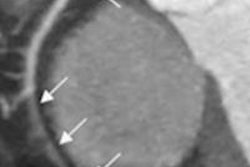Sunday, December 1 | 11:05 a.m.-11:15 a.m. | SSA05-03 | Room N228
Shorter scan lengths for CT pulmonary angiography (CTPA) do not reduce the accuracy of pulmonary embolism diagnosis, but they do cut radiation dose substantially, according to a research team from Wisconsin.CT is the most reliable modality for ruling out pulmonary embolism (PE), even in pregnant women, for whom avoiding unnecessary radiation exposure to the abdomen is of paramount concern. The group from the Medical College of Wisconsin wondered if reducing the anatomic coverage of CT scans in pregnant women would find the necessary pathology while reducing radiation dose.
Examining CT scan data over the previous eight years, the study team used the standard data to create a new series of images based on reduced z-axis coverage that extended only from the aortic arch to the base of the heart. Two experienced readers blinded to the results evaluated the scans for PE, incidental, and other pertinent findings, while a third reader compared the results to the original report that included the standard scan length, determining if any findings had been missed with the shorter scan.
The results showed PE in two patients, both of whom were identified by both readers. Another 32 patients had normal exams, and the remainder had 57 pertinent and incidental findings. The shorter scans missed some benign findings and four previously known lung nodules, but dose was cut by two-thirds.
"Reduced scan range CTPA for pulmonary embolism -- aortic arch to the dome of the lower diaphragm -- can be successfully used in pregnant women," Dr. Larry Goodman told AuntMinnie.com. "No PE or other important diagnosis was missed in the retrospective study of 84 pregnant women studied for PE, and the average dose reduction was 69%."




















